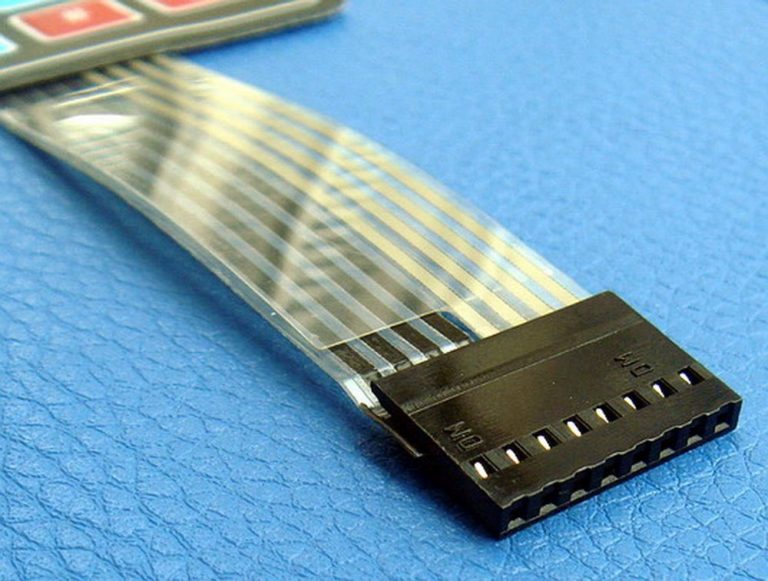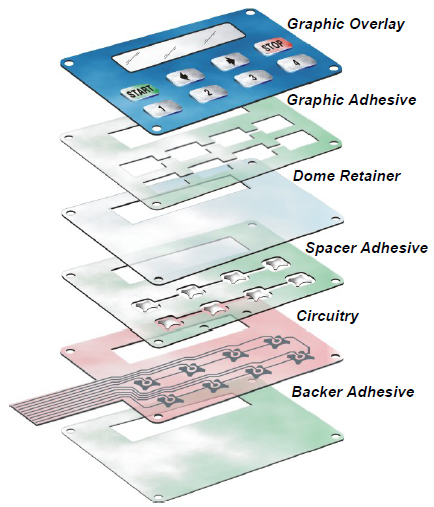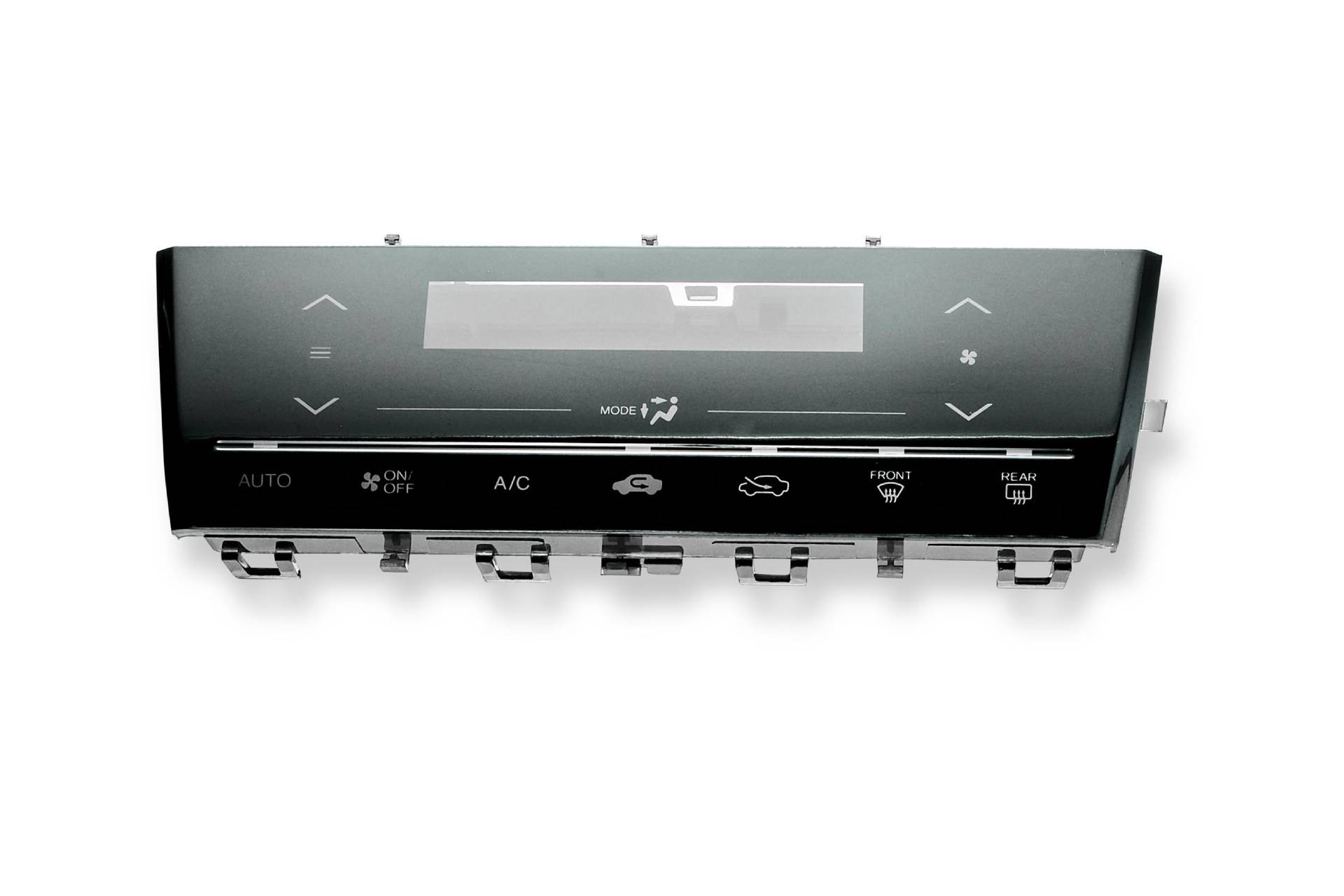Working with a authorized membrane switch manufacturer ensures compliance with technical standards.
What to Seek When Picking a Membrane Switch for Your Job
When you're picking a membrane layer switch for your task, several key elements come right into play. You'll need to assume concerning the products, design, and just how well it aligns with your brand.
Comprehending Membrane Layer Change Elements
When you plunge right into the world of membrane layer buttons, it's important to understand the key elements that make them work. The button commonly includes three primary layers: the graphic overlay, the spacer layer, and the circuit layer. The graphic overlay offers the visual user interface, showing buttons and signs you require for simple navigation. Below that, the spacer layer guarantees there's sufficient range in between the circuit and the overlay, permitting the switch to activate without constant pressure.
The circuit layer, commonly made from printed conductive inks, creates the electric paths. When you press a switch, the circuit closes, sending out a signal to the gadget. Understanding exactly how these layers function with each other aids you pick a membrane layer button that's trustworthy and fits your job demands. Pay close interest to the thickness and material of each layer, as these elements influence durability and functionality in various environments.
Product Choice and Its Effect
Choosing the appropriate materials for your membrane button can significantly affect its performance and durability. The option of substrate, usually polyester or polycarbonate, influences sturdiness and adaptability. Polyester is more abrasion-resistant, while polycarbonate uses much better clarity and strength.
Following, think about the adhesive. It requires to hold up against ecological elements like dampness and temperature level adjustments. A strong sticky warranties that your membrane switch stays intact over time.
Do not forget the visuals overlay. The printing method used, whether silkscreen or digital, influences the button's looks and durability. Top quality inks will withstand fading and scratching, preserving a specialist look.
Lastly, think of ecological conditions. If your device will certainly be exposed to rough chemicals or extreme temperature levels, choose materials developed to sustain these challenges. Your selections in materials will ultimately determine the button's dependability and customer complete satisfaction.
Style Factors To Consider for Individual Experience
Picking the best products lays the structure for a successful membrane switch, yet the layout additionally plays a substantial duty in user experience. You'll intend to review just how the design impacts use (membrane switch manufacturer). Keep buttons and icons instinctive and well-spaced, making it simple for customers to browse without confusion

Shade and comparison are additionally necessary; guarantee that your design is aesthetically attractive yet still useful. High comparison helps customers easily identify switches, particularly in low-light problems.
Last but not least, reflect on the general visual. A streamlined and modern-day style can elevate individual assumption and make your product extra enticing. Stabilizing performance with an appealing layout will certainly result in a far better user experience and eventually, a more effective item.

Environmental Variables and Resilience
When choosing a membrane switch, you need to take into account exactly how it'll execute in various environments. Elements like temperature resistance, wetness and chemical direct exposure, and mechanical wear can substantially impact its resilience. Comprehending these elements will help you choose a switch that takes on your specific conditions.
Temperature Resistance Requirements
As environmental problems can differ commonly, comprehending temperature level resistance is vital for ensuring the durability of your membrane switch. You need to examine the temperature level array in which your tool will certainly run. High temperature levels can trigger materials to degrade, resulting in failing, while low temperature levels might make elements brittle and susceptible to breaking. See to it to examine the requirements of the materials made use of in the button, like the glue and overlay, as they straight effect efficiency. It's additionally a good idea to ponder potential temperature level fluctuations and their results on the button's reliability. By choosing a membrane layer switch with ample temperature level resistance, you'll boost its life-span and keep performance in challenging environments. Choose intelligently to prevent expensive substitutes down the line.

Dampness and Chemical Exposure
Dampness and chemical direct exposure can significantly affect the performance and longevity of your membrane button, so it's vital to recognize the atmosphere in which it will be made use of. Always speak with the maker's requirements for chemical compatibility to assure your membrane layer switch preserves its performance over time. By prioritizing wetness and chemical resistance, you can enhance the toughness of your button in challenging atmospheres.
Mechanical Deterioration
While you may focus on functions like appearances and functionality in your membrane switch, mechanical damage can greatly affect its efficiency in time. Take into consideration exactly how frequently the switch will certainly be utilized and the atmosphere it'll be in. Frequent pressing can bring about destruction of materials, causing issues like tactile responses loss or perhaps change failure. Look for designs with durable designs, such as those with safety overlays that stand up to scrapes and use. Additionally, check for specifications on cycle life, which indicates the number of presses the button can deal with before revealing indications of wear. Picking a sturdy button guarantees longevity and dependability, preventing pricey substitutes and downtime in your job. Constantly consider durability along with visual appeals and capability for peak efficiency.
Customization Options for Branding
When it pertains to branding your membrane button, customization choices are vital. You can pick design aspects and shades that reflect your brand, along with details logo placement and dimension to improve visibility. Furthermore, picking the appropriate products and textures can raise the total look and really feel, making your product stand apart.
Layout Aspects and Colors
A variety of design elements and colors can make your membrane button not simply practical but likewise aesthetically attractive, enhancing your brand identity. When choosing shades, think concerning your brand name's scheme; they need to reverberate with your audience and stimulate the best feelings. You can likewise check out various finishes like matte or glossy to develop different visual results. Don't forget appearances; including a tactile aspect can enhance user experience and make your switch attract attention. Think about integrating personalized graphics or patterns that straighten with your brand message. By attentively picking layout components and shades, you not only develop an item that looks great but additionally enhances your branding continually and effectively.
Logo Positioning and Size
After settling your layout elements and shades, the next action is to concentrate on logo design placement and size. Your logo is an important facet of your branding, so you'll want it to stick out without frustrating various other layout components. Review where your logo design will be most noticeable and impactful; usual placements consist of the leading or facility of the switch.
Do not forget to contemplate just how the logo aligns with customer interaction. This attention to detail will improve both capability and brand identity in your project.
Material and Texture Alternatives
Picking the best materials and structures for your membrane button can considerably boost both its capability and aesthetic charm. You'll desire to assess alternatives like polyester or polycarbonate, as they supply durability and resistance to wear. The appearance of the surface area click for more likewise plays a vital role; smooth finishes supply a streamlined appearance, while textured surfaces can improve hold and tactile feedback.
Customizing the products and textures enables you to mirror your brand identification properly. You may pick a matte coating to convey sophistication or a glossy appearance for a contemporary touch. Don't ignore color options, as vivid colors can make your button stand out, while low-key tones can produce a more classy look
Price vs. High Quality: Finding the Right Equilibrium
When you're handling the options for membrane buttons, balancing price and high quality can really feel frustrating. You desire to guarantee that you're obtaining a trustworthy product without breaking the financial institution. Begin by identifying your job's particular needs. Are you prioritizing sturdiness or appearances? A lower-cost button might save you cash upfront, but if it compromises functionality, you might deal with higher replacement expenses later.
Seek manufacturers that supply an excellent mix of affordability and high criteria. Research their track record and customer reviews to assess integrity. In some cases, spending a little bit a lot more in top quality materials can save you from future migraines.
Also, think about the long-term efficiency and service warranty alternatives. A somewhat more costly switch with a strong service warranty could confirm to be a smarter investment. Eventually, it has to do with locating that pleasant place where you meet your budget plan while ensuring your job's success.
Checking and Quality Control Protocols
While you could find the perfect membrane switch style, guaranteeing its top quality via strenuous testing protocols is vital for lasting success. Beginning by validating that the maker complies with market requirements, such as IPC/WHMA-A -620, to guarantee a trustworthy product. membrane switch manufacturer. You'll want to look for detailed testing methods, including environmental, mechanical, and electric evaluations
Make sure the switches undertake longevity screening, imitating real-world usage to identify any kind of prospective failures. Focus on the manufacturer's top quality guarantee procedure, which should consist of routine inspections and audits.

Do not fail to remember to ask for samples and conduct your very own tests to validate compatibility with your task. Take into consideration just how commonly the producer updates their methods; development in testing can lead to enhanced top quality. By focusing on these screening and quality control methods, you'll enhance the likelihood of a successful and sturdy membrane layer switch for your application.
Regularly Asked Concerns
Exactly how Lengthy Does a Membrane Switch Typically Last?
A membrane layer switch generally lasts anywhere from 1 to 10 million cycles, relying on usage and ecological factors. You'll intend to take into consideration your specific needs to ensure it satisfies your long life requirements successfully.
Can Membrane Switches Be Fixed if Harmed?
Yes, you can sometimes fix membrane switches if they're harmed, but it usually relies on the extent of the damage. Small problems could be fixable, while much more considerable damages usually requires substitute for correct capability.
What Are the Usual Applications for Membrane Buttons?
Membrane switches are generally used in appliances, medical devices, and auto controls. You'll discover them in customer electronics, industrial devices, and even gaming consoles. Their adaptability makes them suitable for numerous interface and settings.
Are There Particular Accreditations for Membrane Switches?
Yes, there are certain certifications for membrane buttons. Look for UL, CE, and RoHS qualifications to ensure safety and compliance. These accreditations suggest the button satisfies market standards for high quality and ecological security.
Just how Do I Make Certain Proper Installation of a Membrane Switch?
To guarantee proper installment of a membrane layer switch, clean the surface area look what i found extensively, align it very home carefully, and use even pressure. Comply with producer guidelines for glue curing time to take full advantage of durability and functionality.
Final thought
When selecting a membrane layer switch for your job, maintain these essential consider mind: prioritize durable materials, emphasis on straightforward layout, and think about customization for your brand name. Equilibrium cost and quality by looking into credible producers with strong quality control procedures. By thoroughly reviewing these aspects, you'll assure your membrane layer switch not just meets your project needs but additionally enhances customer experience and reflects your brand name identity successfully. Make an educated selection, and your job will certainly grow!